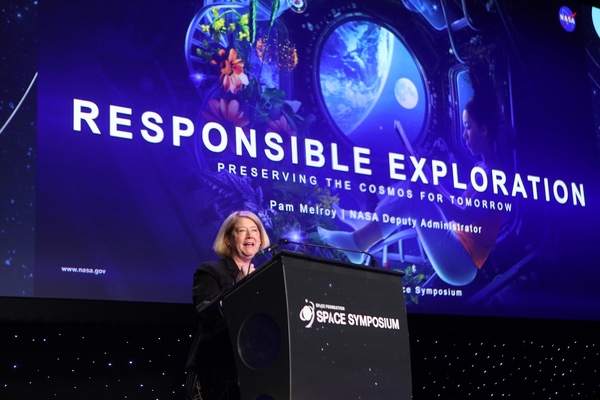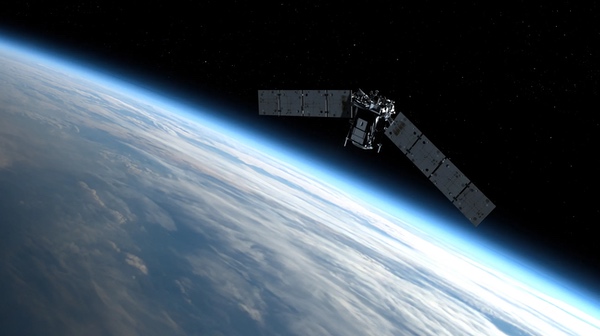NASA’s strategy for space sustainabilityby Jeff Foust
|
| “This time was very different. It was shocking personally, and for all of us at NASA,” Melroy said of the TIMED near-collision. |
Because TIMED could not maneuver and Cosmos 2221 was defunct, there was nothing to do but watch and wait. Fortunately, in the morning NASA gave the all-clear: TIMED was still in contact with ground controllers, indicating that it did not collide with Cosmos 2221.
While satellites pass close to each other in low Earth orbit frequently, this was a particular cause for concern for NASA. “This time was very different. It was shocking personally, and for all of us at NASA,” deputy administrator Pam Melroy said in a speech at the 39th Space Symposium in Colorado Springs. The close approach, later analysis found, had the two spacecraft passing less than ten meters from each other.
She didn’t elaborate on that analysis, but LeoLabs, a company that operates a network of radars to track objects in LEO, had noted the day of the conjunction that it estimated the spacecraft passed within 20 meters of each other, with a probability of collision as high as 8%. A collision, the company estimated, would have created between 2,500 and 7,500 fragments, depending on whether the collision was head-on or glancing. LeoLabs added that it currently tracks nearly 12,000 fragments in LEO.
“Had the two satellites collided, we would have seen significant debris generation,” Melroy said.
The risks posed by orbital debris and collisions in Earth orbit are not new: after all, the idea of the Kessler Syndrome, a runaway cascade of collisions that would render orbits unusable, is decades old. There have been many solutions posed over the years to deal with that debris, from lasers that would be at home in science fiction to concepts like nets and harpoons that instead seem like something from Moby Dick. Surely the right technology is out there somewhere.
But Melroy, in a speech unveiling NASA’s first Space Sustainability Strategy, argued the focus on technology is premature. “That’s the part everyone jumps to first. We think it comes third,” she said.
What she and the agency offered was a more deliberative approach to the issue of space sustainability, one that argues that the problem needs to be better defined and understood before attempting to create any solutions for it. “I’m really picky about strategy,” she said in a later briefing. “I really wanted them to diagnose the problem in a way that got to why it’s so hard to do this.”
One issue is understanding what “space sustainability” means, a term that has gained use in recent years but not necessarily unanimity on what it includes. “NASA defines space sustainability as the ability to maintain the conduct of space activities indefinitely into the future in a manner that is safe, peaceful, and responsible to meet the needs of the present generations while preserving the outer space environment for future activities and limiting harm to terrestrial life,” the strategy states.
However, the document adds, there is no agreement on a “framework” for space sustainability, a model “that describes all quantities of interest and their interdependencies and that can be operationalized through measurements, modeling, and assessments using defined figures of merit.” That creates confusion, the agency concludes, when trying to define space sustainability solutions.
 NASA deputy administrator Pam Melroy discusses NASA’s new Space Sustainability Strategy at the 39th Space Symposium April 9. (credit: Space Foundation) |
The first goal of the strategy is to develop such a framework. “Then we can use that framework to understand the effect of turning not just one knob but turning multiple knobs at once,” Melroy said in her speech.
| “That’s the part everyone jumps to first. We think it comes third,” Melroy said of debris removal technology. |
That directly ties to the strategy’s second goal, which is identifying “critical uncertainties” in that framework. “We aim to minimize those uncertainties and focus specifically on the ones that have the largest impacts,” she said. “We want to seek breakthrough improvements to sense and predict the space environment, explore new operational approaches, and identify cost-effective methods to limit debris creation.”
Only then does the strategy address technologies for addressing debris in the strategy’s third goal. “It’s going to leverage insights from goals one and two to create an investment portfolio focused on advancing the technologies and capabilities that are crucial,” she said.
The strategy includes three other goals that don’t fall in the same linear progression as the first three. One involves developing or updating policies related to space sustainability, such as increased support for orbital debris removal technology development, while another seeks to improve coordination and collaboration with other stakeholders on the issue. A final goal is an internal one for NASA that includes creating a new position of director of space sustainability within the agency.
Melroy and others made clear that the agency's focus is, for now, on that first goal, a space sustainability framework. “The framework is a fundamental thing for us to see success with the strategy,” said Charity Weeden, NASA associate administrator for its office of technology, policy, and strategy, at the briefing. “This is going to look complicated because this is a complicated problem.”
She said the agency was studying that framework and would have more details “on the order of months,” although NASA did not provide any specific timelines. The agency also did not discuss funding for this strategy and efforts like technology development.
“I don’t think we’re ready to talk about the money allocation yet because I think it’s going to be critically important that we have a really tight story about the impact that we hope to have,” Melroy said, returning to the need for a framework. “I often say at the agency that we’ve got to slow down to speed up, which means, let’s figure out what we’re doing first and what kind of impact it’s going to have.”
NASA’s fiscal year 2025 budget request, released last month, noted that the agency is requesting $41.2 million “for space sustainability to better understand and mitigate the hazard of orbital debris,” but doesn’t offer details on how that money would be spent.
Melroy added that the work on the strategy may not be ready in time to inform the fiscal year 2026 budget proposal, which is already in early stages of development at NASA. “We hope to have answers and thoughts that we can then propose in the ’27 budget that are aligned with the things that we’ve learned,” she said. “Everything is driven by the budget schedule.”
She also said that while NASA will work with other government agencies on the issue of space sustainability, like the Office of Space Commerce, which is setting up a civil space traffic coordination system called TraCSS, NASA has no desire to get involved as a regulatory agency or operational player.
“There are people who I think would love to see us as the Space Coast Guard,” she said, with NASA preferring to stay in a role as a science and technology development agency. “We’re not a regulatory agency and we’re happy that it is that way.”
In her speech about the new strategy, she returned to the issue of the TIMED close approach to the defunct Russian satellite. “The TIMED spacecraft really scared us all,” she said. That incident could be excused by the fact that TIMED was an old spacecraft, launched in 2001, launched in an era where there was less concern, if any, about space sustainability. The defunct Cosmos 2221 was even older, launched in the early 1990s. Surely we are doing better today?
| “The framework is a fundamental thing for us to see success with the strategy,” said Weeden. “This is going to look complicated because this is a complicated problem.” |
Another incident that took place a little more than a week after the TIMED conjunction suggests otherwise. On March 8, a battery pallet from the International Space Station reentered. That pallet, weighing more than two and a half metric tons was discarded from the station three years earlier to make an uncontrolled reentry. It was to have been disposed on a Japanese cargo spacecraft, but a cascading series of delays dating back several years meant that there was no cargo spacecraft available to allow the pallet to make a controlled reentry.
The pallet reentered, according to US Space Force tracking data, over the Gulf of Mexico between Mexico and Florida. That appeared to be the end of the story, until a homeowner in Naples, Florida, told local media that an object fell from the sky that day and through the roof of his house, causing minor damage. Naples, in southwest Florida, was on the trajectory of that pallet if it remained in orbit just a few more minutes that predicted.
NASA announced last week than an analysis of the object, a slug of metal weighing about three-quarters of a kilogram, confirmed it was Inconel from equipment used to mount the batteries on the pallet. The ISS program, NASA said in a statement, “will perform a detailed investigation of the jettison and re-entry analysis to determine the cause of the debris survival and to update modeling and analysis, as needed.”
“NASA remains committed to responsibly operating in low Earth orbit, and mitigating as much risk as possible to protect people on Earth when space hardware must be released,” the agency added in that statement. There’s clearly more work for NASA to do as it refines its approach for space sustainability.
Note: we are now moderating comments. There will be a delay in posting comments and no guarantee that all submitted comments will be posted.
